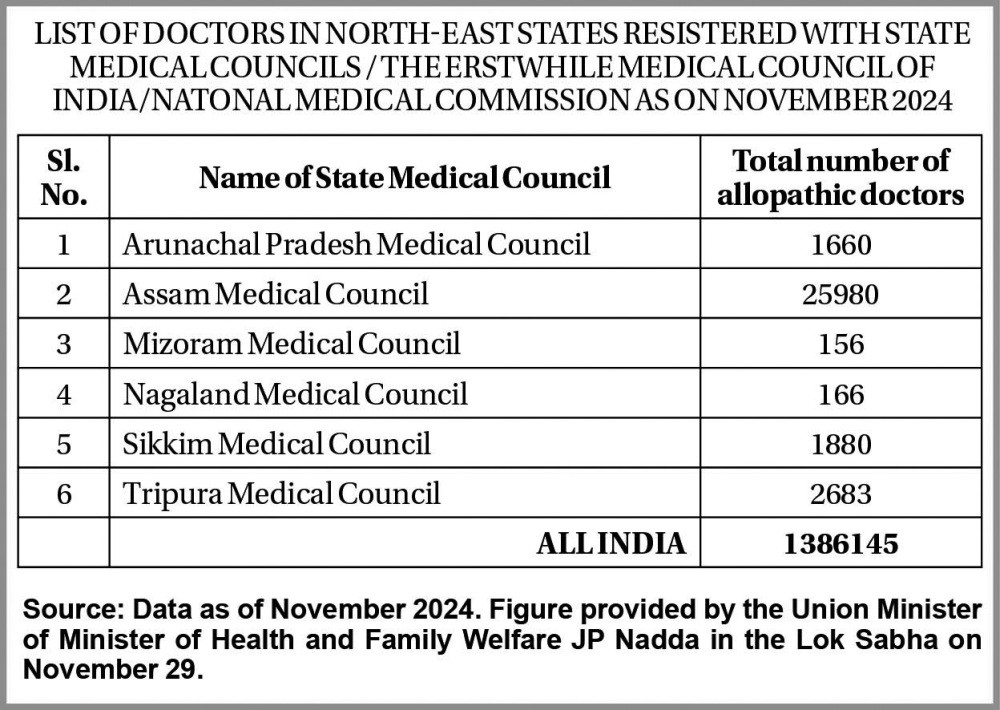
MoHFW data reveals low registration with State Medical Council
Morung Express News
Dimapur | December 1
The registration of allopathic doctors in Nagaland with the mandated State Medical Council (SMC) continues to be among the lowest in India, according to the latest data presented in Parliament.
As of November 2024, only 166 doctors were registered with the Nagaland Medical Council (NMC), according to data provided by the Union Health Minister, JP Nadda, in the Lok Sabha on November 29. This figure is only marginally higher than Mizoram, which has 156 registered doctors under its SMC.
The NMC, a statutory body established in 2014 under the Nagaland Medical Council Act of 2014, facilitates the registration of allopathic doctors in the state. However, despite regular notifications for registration by the NMC, the impact has been limited so far.
The number of registered doctors with the NMC increased by only 25 since June 2022, when it stood at 141, as highlighted in another written reply by the Union Ministry of Health and Family Welfare (MoHFW) in the Rajya Sabha in December 2023.
Given Nagaland’s population of approximately 19.78 lakh (2011 Census), the doctor-population ratio for allopathic doctors translates to around 1:12,000 (11,918.68), equating to one doctor for every 12,000 people.
This is significantly higher than the World Health Organization’s (WHO) recommended standard of 1:1,000.
Meanwhile, the Nagaland Minister for Health & Family Welfare informed the Assembly on August 29 that there were 413 doctors in positions across various health units in the state.
If this is taken into account, the ratio comes down to around 1 doctor for every 4,800 persons (4,790.56), still well above the prescribed norms.
Further, in October, the Deputy Director of AYUSH in the Department of Health and Family Welfare (DoHFW) reported that there were 142 AYUSH doctors in Nagaland.
When combined with the number of allopathic doctors, the total rises to 555, bringing the doctor-population ratio to approximately 1:3,564.86. Nevertheless, this remains well above the WHO benchmark.
Since 2011, the population has increased, with most projections estimating Nagaland’s population at over 2 million.
For instance, the MoHFW in April projected Nagaland’s ‘Mid-year projected population as on 1st October, 2024’ at 2,264,000.
If this is taken into account to measure the overall doctor-population ratio, it is around 1:4,079.27. This figure is more or less in line with the one quoted by MLA Dr Sukhato A Sema during the annual conference of the Nagaland In-Service Doctors Association (NIDA) on November 24, who noted the concerning doctor-population ratio of 1:4,056 in the state.
When compared to other North-East states, Nagaland's registration is notably low. Assam leads with 25,980 registered doctors, followed by Tripura with 2,683, Sikkim with 1,880, and Arunachal Pradesh with 1,660.
All-India ratio
On the national scale, data presented by the Union Health Minister in Parliament on November 29 reveals that, as of November 2024, there are 1,386,145 allopathic doctors registered with State Medical Councils and the National Medical Commission.
At the national level, the Maharashtra Medical Council has the highest registration in India, with 209,540 doctors, followed by Tamil Nadu with 149,399, and Andhra Pradesh with 105,805.
Assuming an 80% availability of registered allopathic doctors, coupled with approximately 6.14 lakh AYUSH doctors, India’s overall doctor-population ratio is estimated at 1:811, which is better than the WHO standard, he maintained.
To improve the doctor-population ratio, the Minister said that the government has undertaken several initiatives, including increasing the number of medical colleges and MBBS seats. Since 2014, medical colleges have increased by 102%, from 387 to 780, while MBBS seats have risen by 130%, from 51,348 to 1,18,137. Postgraduate seats have also seen a 135% increase, from 31,185 to 73,157, he added.
Other measures include sponsoring schemes for establishing new medical colleges by upgrading district or referral hospitals and strengthening existing government medical colleges to increase MBBS and postgraduate seats.
Under the “Upgradation of Government Medical Colleges by Construction of Super Speciality Blocks” initiative of the Pradhan Mantri Swasthya Suraksha Yojana (PMSSY), 75 projects have been approved, with 69 completed, Nadda said. Furthermore, 22 new AIIMS have been approved under the Central Sector Scheme, he added.





